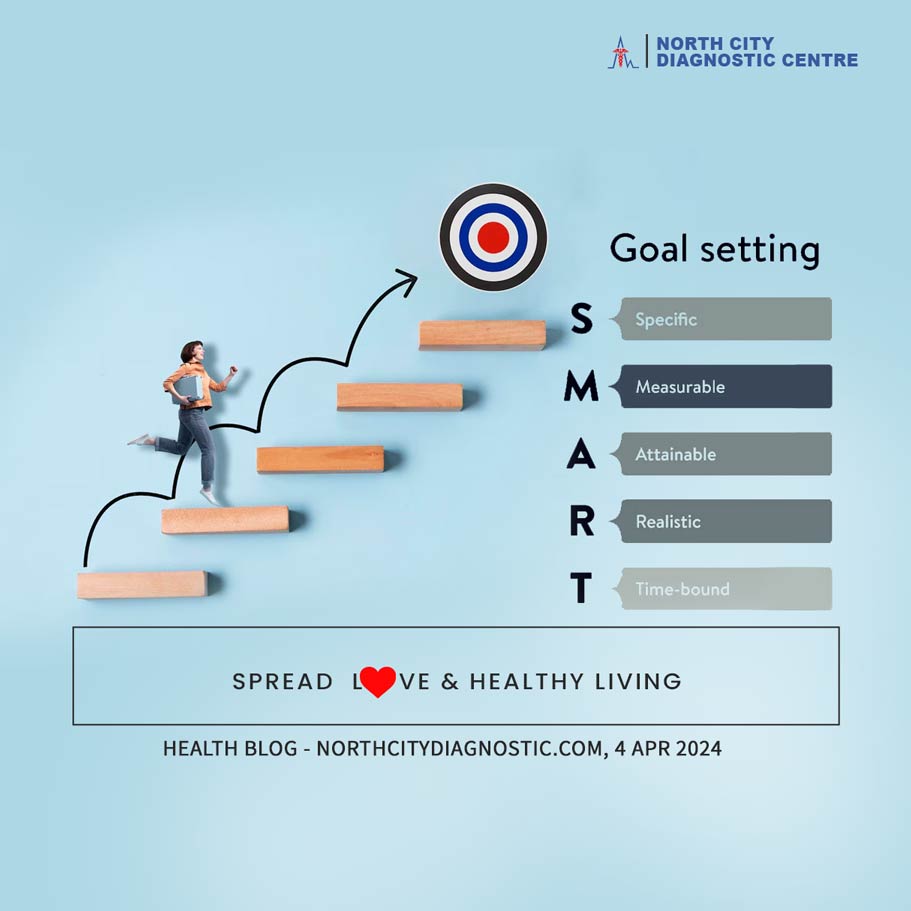
Menu
Improving your health is one of the most valuable investments you can make in yourself. Whether you’re aiming to lose weight, increase your fitness level, or simply adopt healthier habits, setting clear and achievable goals is essential. Let us explore the concept of SMART goals and how they can be applied to enhance your journey towards better health.

“A person should set his goals as early as he can and devote all his energy and talent to getting there.”
– Walt Disney
SMART is an acronym that stands for Specific, Measurable, Achievable, Relevant, and Time-bound. This framework provides a structured approach to goal setting, making your objectives more concrete and actionable. Let’s break down each component:
A specific goal is well-defined and clear, leaving no room for ambiguity. It outlines exactly what you want to accomplish, including the who, what, where, when, and why. The first step towards SMART Goals.
Let’s consider an example:
General Goal: “I want to improve my fitness.”
Specific Goal: “I want to lower my body fat percentage by 5%.”
In this example, the specific goal provides clear details about what aspect of fitness you want to improve (body fat percentage) and by how much (5%). It specifies the outcome you’re aiming for, making it easier to understand and pursue effectively. Additionally, it helps to identify the focus of your efforts and provides a clear direction for action.
Overall, setting specific goals ensures that you have a clear understanding of what you want to achieve, which increases your motivation, focus, and likelihood of success.
A measurable goal can be quantified or evaluated using specific criteria. It involves identifying tangible metrics or indicators that allow you to track your progress and determine whether you’re moving closer to achieving your objective.
Let’s illustrate this with an example:
Specific Goal: “I want to improve my overall fitness level.”
While this goal is specific in targeting fitness, it lacks measurability because it doesn’t provide a clear way to assess progress or success.
Measurable Goal: “I want to increase the number of push-ups I can do in one minute from 20 to 40 within three months.”
In this example, the goal is measurable because it specifies a quantifiable metric (number of push-ups) and a timeframe (three months) for achieving the desired improvement. By tracking the number of push-ups performed within one minute, you can objectively measure progress over time and determine whether you’re moving closer to your goal.
By setting measurable goals allows you to track your progress objectively and determine whether you’re making meaningful strides towards achieving your objectives. It provides clarity and accountability, helping you stay focused and motivated on your journey towards success.
An achievable goal is one that is realistic and attainable within the constraints of your current circumstances, resources, and capabilities. It ensures that your objectives are within reach with effort and commitment, without being overly ambitious or unattainable.
Let’s illustrate this with an example:
Specific Goal: “I want to lower my body fat percentage by 10% in one month.”
While this goal is specific, it may not be achievable for most individuals within such a short timeframe. Losing 10% of body fat in just one month could require extreme measures that are not sustainable or healthy.
Achievable Goal: “I want to lower my body fat percentage by 1% in one month.”
By adjusting the goal to a more modest decrease of 1% in body fat percentage, it becomes more achievable for most people. This goal is still specific and measurable, but it sets a more realistic expectation for progress over the given timeframe.
Setting achievable goals ensures that you set yourself up for success by considering your capabilities and limitations. It allows you to challenge yourself while maintaining a realistic and sustainable approach to goal attainment.
A relevant goal is one that is aligned with your overall objectives, values, and priorities. It ensures that your efforts are focused on areas that are meaningful and contribute to your personal or professional growth.
Let’s take a look at this example:
Specific Goal: “I want to learn Spanish.”
While learning a new language is a valuable skill, the relevance of this goal may vary depending on your personal circumstances and objectives. For example, if your primary goal is to advance your career in international business, learning Spanish could be highly relevant. However, if your main focus is on improving your physical fitness, learning Spanish may not directly contribute to that objective.
Relevant Goal: “I want to enroll in a fitness certification course to become a certified personal trainer within six months.”
In this example, the goal is relevant because it directly aligns with your objective of improving physical fitness. By becoming a certified personal trainer, you not only enhance your own fitness knowledge and skills but also open up opportunities for career advancement in the fitness industry. This goal is meaningful and contributes to your overall growth and development in a relevant area.
Setting relevant goals ensures that your efforts are directed towards activities that matter to you and support your overarching objectives. It helps you stay focused and motivated by pursuing goals that align with your values, interests, and aspirations.
A time-bound goal is one that has a specific deadline or timeframe for completion. It provides a sense of urgency and accountability, helping you stay focused and motivated to take action within a defined period.
Let’s illustrate this with an example:
Specific Goal: “I want to lose 10 pounds.”
While this goal is specific, it lacks a timeframe for achieving the desired weight loss, making it challenging to track progress and maintain motivation.
Time-bound Goal: “I want to lose 10 pounds in three months.”
In this example, the goal is time-bound because it includes a specific deadline (three months) for achieving the desired weight loss. Having a clear timeframe creates a sense of urgency and helps you stay on track with your efforts. It also allows you to break down the goal into smaller, manageable tasks and monitor progress more effectively.
Setting time-bound goals ensures that you have a sense of urgency and accountability, making it more likely that you’ll take consistent action towards achieving your objectives. It helps you stay focused, motivated, and on track with your efforts, ultimately increasing your chances of success.
Setting SMART goals is a powerful strategy for improving your health and well-being. By making your objectives Specific, Measurable, Achievable, Relevant, and Time-bound, you create a roadmap for success and increase your chances of achieving lasting results. Whether you’re aiming to improve your fitness, nutrition, weight, or stress levels, applying the SMART framework can help you stay focused, motivated, and accountable on your journey to better health. Start today by setting SMART goals that align with your health priorities and take proactive steps towards a healthier, happier you.
At North City Diagnostic Center we offer personalized testing schedule that aligns with your medical history and risk factors. Consistent monitoring can be invaluable for early detection and effective management of arthritis. It’s not just about how often you test but making sure that the tests are aligned with your overall health profile for maximum benefit.
#Health #Wellness #Fitness #HealthyLiving #Nutrition #Exercise #MentalHealth #SelfCare #HealthyLifestyle #Healthylife #Wellbeing #HealthyChoices #HealthTips #FitnessGoals #HealthyEating #HealthyHabits #FitLife #GetHealthy #HealthJourney #WellnessWednesday #NDC #HealthFirst #DiagnosticServices #NorthCityDiagnosticCentre
35-A ,Canal West Road
Near Gouri Bari Bus Stop
Kolkata – 700004.
Local: +91 33 6605 0888